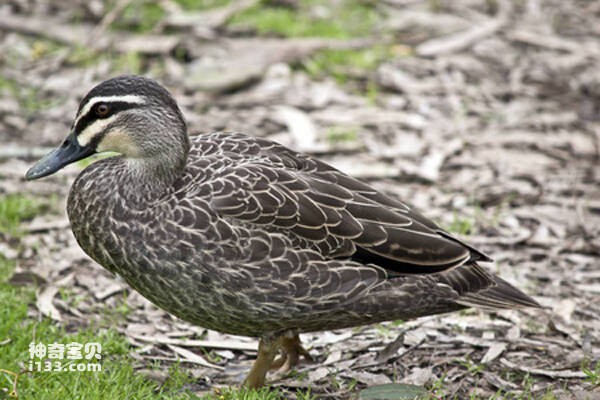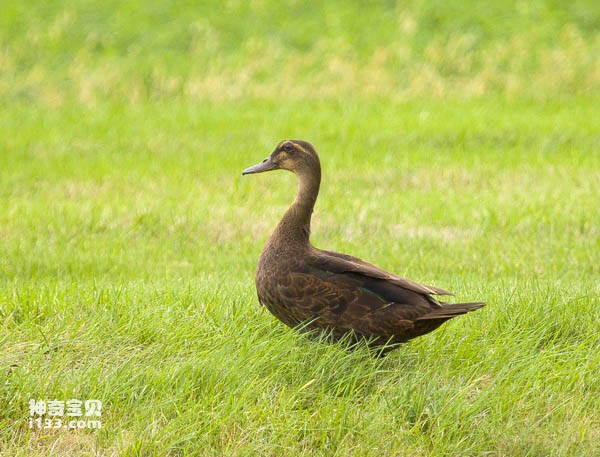Anas superciliosa
IUCN
LCBasic Information
Scientific classification
- name:Anas superciliosa
- Scientific Name:Anas superciliosa,Pacific Black Duck,Grey Duck
- Outline:Waterfowl
- Family:
Vital signs
- length:47-61cm
- Weight:560-1400g
- lifetime:About 20 years
Feature
The overall plumage is mainly mottled brown, brown and light yellow, with dark brown to light yellow stripes and spots throughout the body
Distribution and Habitat
Place of origin: American Samoa, Australia, Cook Islands, Fiji, Society Islands of French Polynesia, Indonesia (southern Sumatra, Java and Sulawesi), Marshall Islands, Caroline Islands of the Federated States of Micronesia, New Caledonia, Cook Islands of New Zealand, Palau, Papua New Guinea (New Britain and New Ireland), Solomon Group Islands, Vanuatu, New Caledonia (French), Samoa, Solomon Islands, Timor-Leste, Fiji, Tonga and Vanuatu.
The Pacific black duck is a common wild duck in Australia, with a wide range of terrestrial, Marine wetland and estuarine breeding and breeding tolerance, and is found in wetlands throughout Australia. They usually inhabit freshwater lakes, but also live in groups in rivers, lakes, reservoirs, forest ponds, tidal mudflats, bays and coastal salt flats, giving preference to shallow, well-vegetated swamps, wetlands, protected estuaries and sheltered coastal waters. From streams, rivers, and small freshwater ponds to (more rarely) hidden ocean waters; Ve
Appearance
The Pacific black duck is 47-61 cm long, weighs 642-1400 g for males and 560-1400 g for females, and has a wingspan of 82-93 cm. The body size is larger. The overall plumage is mainly mottled brown, brown and light yellow. The body has dark brown to light yellow stripes and spots, and the feathers have white or yellow edges. The head is pale, with distinct dark stripes, with dark brown as the middle color line, bordered by a cream-colored, dark brown crown above and below the eyes, forming long and striking broad stripes. The crown is black, the face is white to pale yellow, and the throat is white. The upper wing coverts are the same color, and the secondary wings are bright and shiny, with iridescent glowing green wing mirrors. The white underside of the wings is prominent in flight.
The female has the same plumage as the male, but the crest is brown instead of black. Young Pacific black ducks have feathers similar to those of adult ducks.
Iris brown, beak lead. Legs and feet a
Details
The Pacific Black Duck (Anas superciliosa) is a medium sized swimming bird in the family Anatidae.

Pacific black ducks usually appear in pairs or small flocks, easily mixing with other ducks, and are a common spot for lake viewing and urban ponds, where the ducks become very docile. Generally in pairs or small groups of activities, mostly choose in the water side of the marsh area of wild grass. They mostly float on the surface and get their food underwater. Ducks have webbed toes, but rarely dive, swim with their tails out of the water, and are good at feeding, splashing and mating in the water. Like clean, often in the water and on the land preening carefully dressed.
Pacific black ducks eat a diet of plants, including roots, grass seeds, leaves, grass fruits, rice, and sometimes animal foods, including invertebrates and arthropods, such as insects, snails, and crayfish. A song is a loud, rapid rattle that starts out very loud and then gradually diminishes.

The Pacific black duck's breeding season peaks during the rainy season and pairs in late summer or early fall. The male flaps and chases the female with his wings during the courtship ritual. The nest is usually located away from water and is usually built in a hollow tree. Sometimes they choose to be higher than the nearby water, hidden in the water grass, and build a bowl-shaped nest with plant grass stems. Each nest lays 4-12 eggs and incubates for 21-25 days. It is usually hatched by the female alone, while the male ducks stay close to guard the nest. After hatching, the ducklings are still taken care of by the female ducks, and the ducklings follow the female ducks for food. The young leave the nest in 49 days. Young ducks can breed after a year, but the survival rate of young ducks is only about 35%. Adult ducks live an average of 21 months in New Zealand, but the longest living Pacific black duck in the wild can live for at least 20 years.
Due to a combination of competition and interbreeding with mallards, the Pacific black duck is thought to be in decline throughout its range. This introduced species is most common in developed areas and, at least in New Zealand, is still increasing in numbers. Also in New Zealand, wild habitat loss is thought to be the main cause of population decline, with slow declines in Melanesia due to hunting and habitat degradation. Habitat destruction has also occurred in Australia, but Pacific black ducks there have proven better able to make use of artificial habitats.
Listed on the International Union for Conservation of Nature Red List of Threatened Species (IUCN) 2018 ver 3.1 - Not Threatened (LC).
Protect wild animals and eliminate wild meat.
Maintaining ecological balance is everyone's responsibility!








